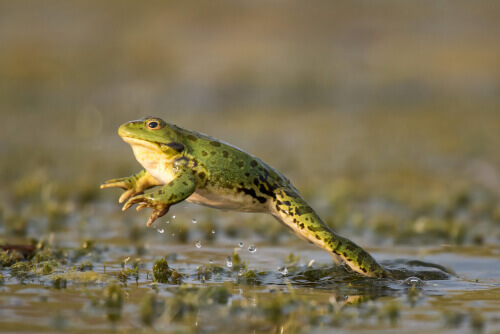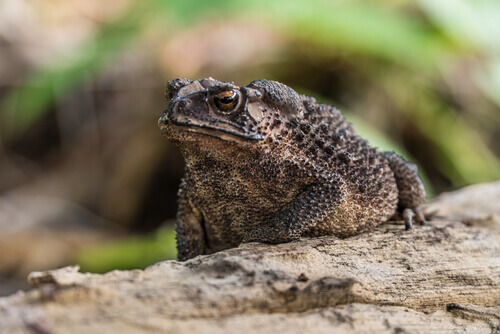The Differences Between Toads and Frogs

Toads and frogs belong to the same family, but if we look closely, we can distinguish them. We’ll give you the keys to find the differences between toads and frogs, as it’s not always easy!
The complicated differences between toads and frogs
Frogs and toads belong to the same family of amphibians: the anurans. They have a few characteristics in common, and a few differences that divide them.
Both toads and frogs are amphibians and have a short, round body. Both have four legs, of which the hind legs are stronger. They have large, lively eyes, but, unlike salamanders, they don’t have tails. They can be of many different colors and have a similar diet, based on insects and other small animals.
In addition to all these similarities, we can notice a few differences between toads and frogs. There are a few characteristics that we can notice at first glance and others that require more in-depth study.
The appearance of the skin
One of the most obvious differences between toads and frogs is their skin. Frogs have smooth, shiny skin, which usually appears to be moist. In addition, they can be of very different colors. Some of the most colorful animals on the planet are frogs, such as poison dart frogs. Common frogs found in wetlands will be bright green and yellow.

This can be explained by their different habitats.
The habitat
Although both species are amphibians, frogs live in wetter areas than toads, which can go without water for longer periods of time.
Frogs live in rivers and ponds, or anywhere with sufficient moisture. Their skin looks wet because it is, in fact, damp. Frogs don’t usually stay away from their aquatic habitat for too long, although they may make short trips on land in search of food.
Toads, on the other hand, may stay away from the water much longer. Sometimes they hide in the ground and stay away for hours or days from rivers or ponds; thanks to their brownish color they go unnoticed very easily.

and toadsproduce tadpoles
Webbed feet and toes
If we come across an anuran and want to know if it’s a toad or a frog, and neither the habitat nor the appearance of the skin gives us the clues, there are other differences between toads and frogs that we can take into account. For example, their legs.
Frog’s legs are stronger and more dexterous than those of toads and, because of this, frogs can make long leaps to move around. On the other hand, toads’ legs are only capable of propelling them by small hops, and they will have a hard time climbing trees or bushes.
Another subtle difference is in their toes. Frogs usually have webbed feet, meaning that between their toes they have a membrane. Thanks to this, it’s much easier for them to manage in the water. Toads, because they’re better prepared to move on land, lack this membrane.
The ultimate proof: DNA
Despite all this, there are species where the differences between toads and frogs are unclear or confusing. For example, there are species of toads with smooth, shiny skin, and species of frogs with short, weak legs.
Therefore, the definitive test to know if an animal belongs to the frog or the toad family is a DNA test. Some species can be distinguished only at a genetic level.
The differences between toads and frogs are many. Their skin and their legs are clues that we can use to identify them. However, some species are ambiguous and we’ll need the help of an expert to determine which species each animal belongs to.
This text is provided for informational purposes only and does not replace consultation with a professional. If in doubt, consult your specialist.